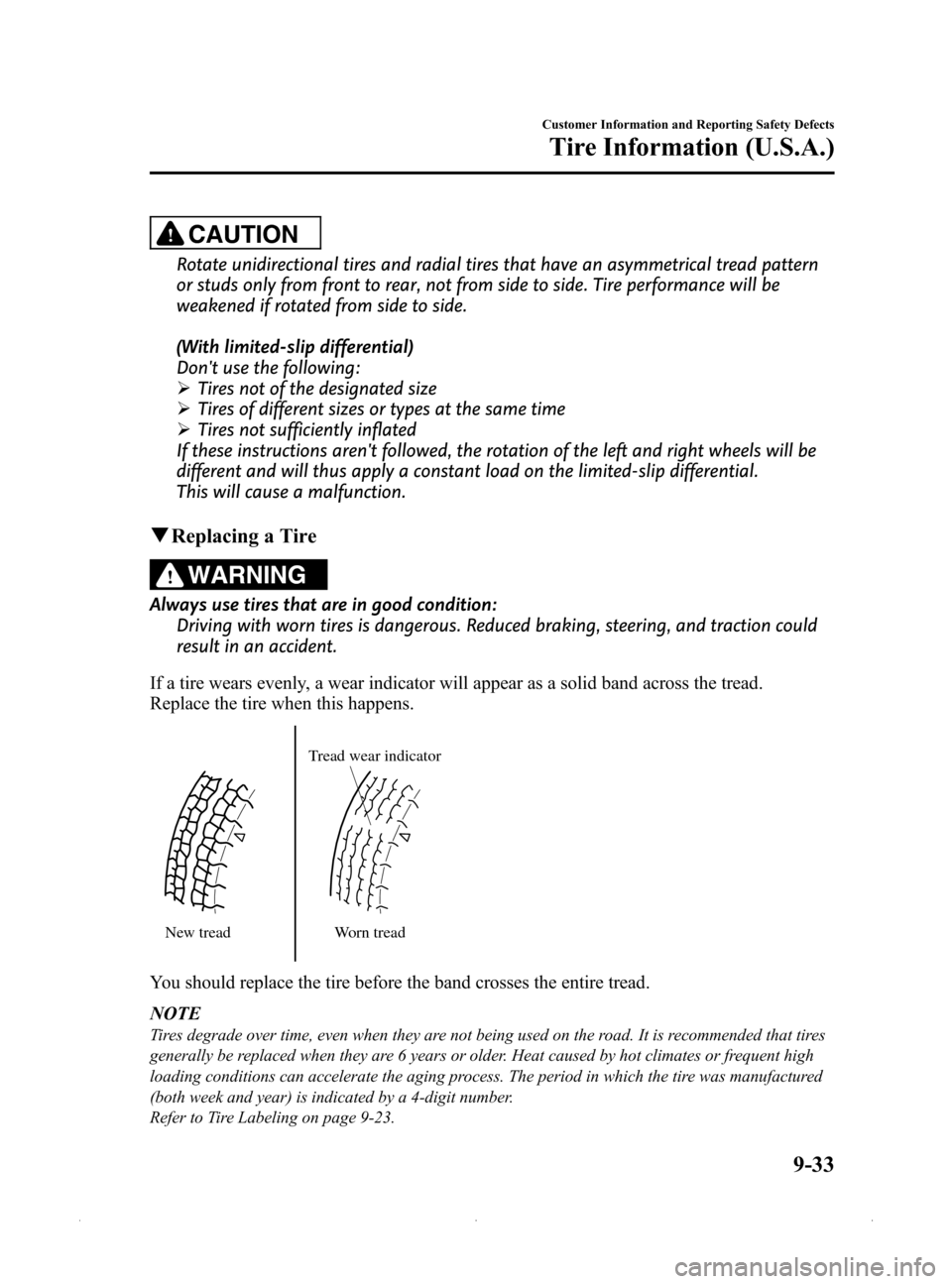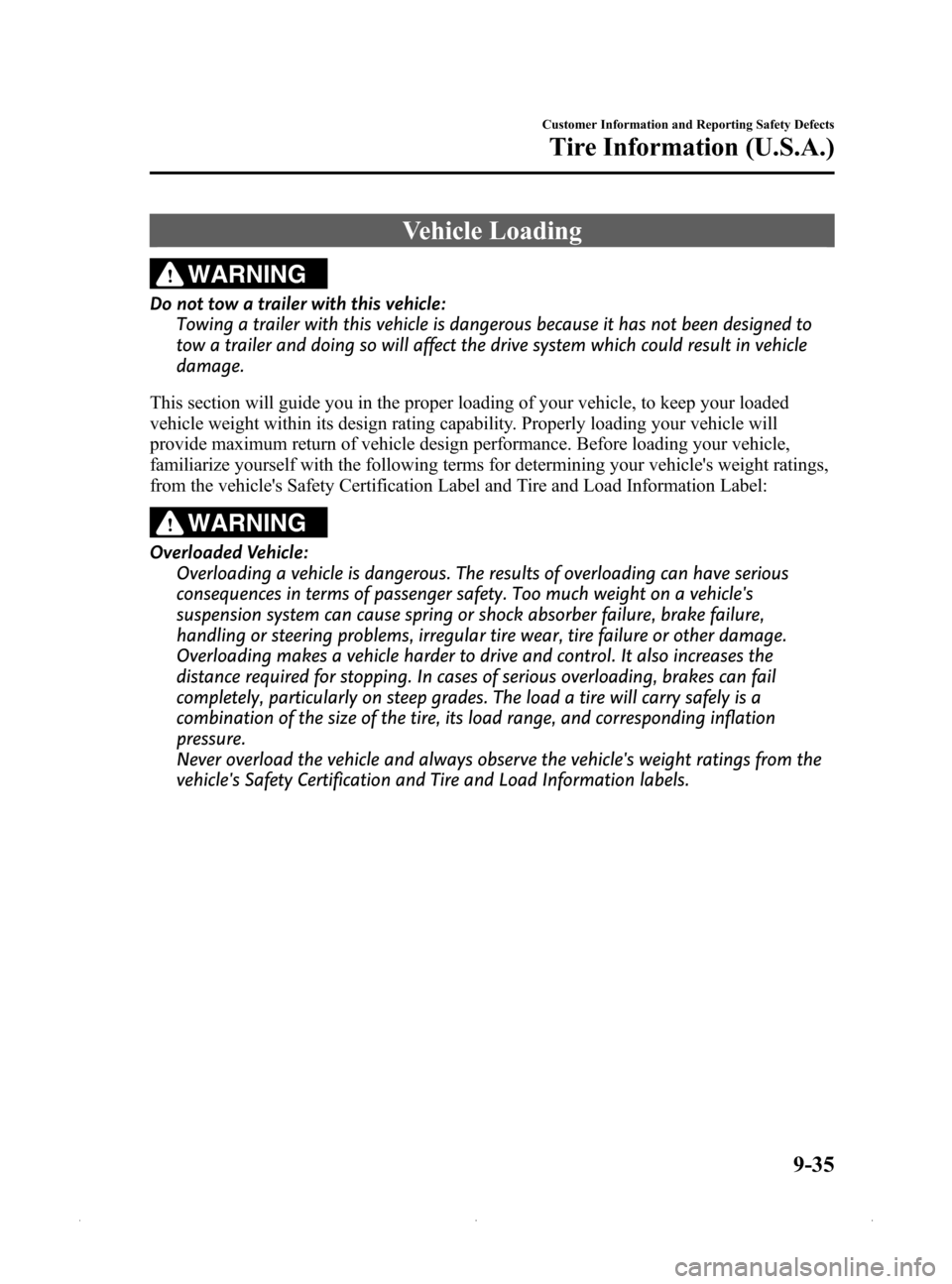MAZDA MODEL MX-5 2015 Owners Manual (in English)
Manufacturer: MAZDA, Model Year: 2015, Model line: MODEL MX-5, Model: MAZDA MODEL MX-5 2015Pages: 448, PDF Size: 5.4 MB
Page 421 of 448

Black plate (421,1)
CAUTION
Rotate unidirectional tires and radial tires that have an asymmetrical tread pattern
or studs only from front to rear, not from side to side. Tire performance will be
weakened if rotated from side to side.
(With limited-slip differential)
Don't use the following:
ØTires not of the designated size
Ø Tires of different sizes or types at the same time
Ø Tires not sufficiently inflated
If these instructions aren't followed, the rotation of the left and right wheels will be
different and will thus apply a constant load on the limited-slip differential.
This will cause a malfunction.
q Replacing a Tire
WARNING
Always use tires that are in good condition:
Driving with worn tires is dangerous. Reduced braking, steering, and traction could
result in an accident.
If a tire wears evenly, a wear indicator will appear as a solid band across the tread.
Replace the tire when this happens.
New tread Tread wear indicator
Worn tread
You should replace the tire before the band crosses the entire tread.
NOTE
Tires degrade over time, even when they are not being used on the road. It is recommended that tires
generally be replaced when they are 6 years or older. Heat caused by hot climates or frequent high
loading conditions can accelerate the aging process. The period in which the tire was manufactured
(both week and year) is indicated by a 4-digit number.
Refer to Tire Labeling on page 9-23.
Customer Information and Reporting Safety Defects
Tire Information (U.S.A.)
9-33
MX-5_8EN7-EA-14E_Edition1 Page421
Friday, March 28 2014 3:42 PM
Form No.8EN7-EA-14E
Page 422 of 448

Black plate (422,1)
qSafety Practices
The way you drive has a great deal to do with your tire mileage and safety. So cultivate
good driving habits for your own benefit.
lObserve posted speed limits and drive at speeds that are safe for the existing weather
conditions
lAvoid fast starts, stops and turnslAvoid potholes and objects on the roadlDo not run over curbs or hit the tire against the curb when parking
CAUTION
If you feel a sudden vibration or ride disturbance while driving or you suspect your
tire or vehicle has been damaged, immediately reduce your speed. Drive with caution
until you can safely pull off the road. Stop and inspect the tire for damage. If the tire
is under-inflated or damaged, deflate it, remove the tire and rim and replace it with
your spare tire. If you cannot detect a cause, have the vehicle towed to the nearest
vehicle or tire dealer to have the vehicle inspected.
9-34
Customer Information and Reporting Safety Defects
Tire Information (U.S.A.)
MX-5_8EN7-EA-14E_Edition1 Page422
Friday, March 28 2014 3:42 PM
Form No.8EN7-EA-14E
Page 423 of 448

Black plate (423,1)
Vehicle Loading
WARNING
Do not tow a trailer with this vehicle:Towing a trailer with this vehicle is dangerous because it has not been designed to
tow a trailer and doing so will affect the drive system which could result in vehicle
damage.
This section will guide you in the proper loading of your vehicle, to keep your loaded
vehicle weight within its design rating capability. Properly loading your vehicle will
provide maximum return of vehicle design performance. Before loading your vehicle,
familiarize yourself with the following terms for determining your vehicle's weight ratings,
from the vehicle's Safety Certification Label and Tire and Load Information Label:
WARNING
Overloaded Vehicle: Overloading a vehicle is dangerous. The results of overloading can have serious
consequences in terms of passenger safety. Too much weight on a vehicle's
suspension system can cause spring or shock absorber failure, brake failure,
handling or steering problems, irregular tire wear, tire failure or other damage.
Overloading makes a vehicle harder to drive and control. It also increases the
distance required for stopping. In cases of serious overloading, brakes can fail
completely, particularly on steep grades. The load a tire will carry safely is a
combination of the size of the tire, its load range, and corresponding inflation
pressure.
Never overload the vehicle and always observe the vehicle's weight ratings from the
vehicle's Safety Certification and Tire and Load Information labels.
Customer Information and Reporting Safety Defects
Tire Information (U.S.A.)
9-35
MX-5_8EN7-EA-14E_Edition1 Page423
Friday, March 28 2014 3:42 PM
Form No.8EN7-EA-14E
Page 424 of 448

Black plate (424,1)
Base Curb Weight is the weight of the vehicle including a full tank of fuel and all
standard equipment. It does not include passengers, cargo, or optional equipment.
Vehicle Curb Weightis the weight of your new vehicle when you picked it up from your
dealer plus any aftermarket equipment.
PAYLOAD
Payload is the combination weight of cargo and passengers that the vehicle is designed to
carry. The maximum payload for your vehicle can be found on the Tire and Load
Information label on the driver's door frame or door pillar. Look for “THE
COMBINATION WEIGHT OF OCCUPANTS AND CARGO SHOULD NEVER
EXCEED XXX kg or XXX lbs” for your maximum payload. The payload listed on the tire
label is the maximum payload for the vehicle as built by the assembly plant. If any
aftermarket or dealer installed equipment has been installed on the vehicle, the weight of
the equipment must be subtracted from the payload listed on the tire label in order to be
accurate.
9-36
Customer Information and Reporting Safety Defects
Tire Information (U.S.A.)
MX-5_8EN7-EA-14E_Edition1 Page424
Friday, March 28 2014 3:42 PM
Form No.8EN7-EA-14E
Page 425 of 448

Black plate (425,1)
SAMPLE
CARGO
Cargo Weightincludes all weight added to the Base Curb Weight, including cargo and
optional equipment.
The cargo weight limit decreases depending on the number of vehicle occupants. The cargo
weight limit can be calculated by subtracting the total weight of the vehicle occupants from
the “combination weight of occupants and cargo should never exceed ”value on the tire
label.
Customer Information and Reporting Safety Defects
Tire Information (U.S.A.)
9-37
MX-5_8EN7-EA-14E_Edition1 Page425
Friday, March 28 2014 3:42 PM
Form No.8EN7-EA-14E
Page 426 of 448

Black plate (426,1)
Examples: Based on a single occupant weight of 68 kg (150 lbs), and a value of 385 kg
(849 lbs) for the“combination weight of occupants and cargo should never exceed ”:
The cargo weight limit with one occupant is 385 kg (849 lbs) _
68 kg (150 lbs) = 317 kg
(699 lbs)
The cargo weight limit with two occupants is 385 kg (849 lbs) _
(68 × 2) kg ( (150 × 2)
lbs) = 249 kg (549 lbs)
If the weight of the occupant increases, the cargo weight limit decreases by that much.
GAW (Gross Axle Weight) is the total weight placed on each axle (front and rear) -
including vehicle curb weight and all payload.
GAWR (Gross Axle Weight Rating) is the maximum allowable weight that can be carried
by a single axle (front or rear). These numbers are shown on the Safety Compliance
Certification Label located on the driver's door frame or door pillar. The total load on
each axle must never exceed its GAWR.
GVW
GVW (Gross Vehicle Weight) is the Vehicle Curb Weightcargopassengers.
GVWR (Gross Vehicle Weight Rating) is the maximum allowable weight of the fully
loaded vehicle (including all options, equipment, passengers and cargo). The GVWR is
shown on the Safety Compliance Certification Label located on the driver's door
frame or door pillar. The GVW must never exceed the GVWR.
9-38
Customer Information and Reporting Safety Defects
Tire Information (U.S.A.)
MX-5_8EN7-EA-14E_Edition1 Page426
Friday, March 28 2014 3:42 PM
Form No.8EN7-EA-14E
Page 427 of 448

Black plate (427,1)
SAMPLE
WARNING
Exceeding Axle Weight Rating Limits:Exceeding the Safety Certification Label axle weight rating limits is dangerous and
could result in death or serious injury as a result of substandard vehicle handling,
performance, engine, transmission and/or structural damage, serious damage to the
vehicle, or loss of control.
Always keep the vehicle within the axle weight rating limits.
Do not tow a trailer with this vehicle: Towing a trailer with this vehicle is dangerous because it has not been designed to
tow a trailer and doing so will affect the drive system which could result in vehicle
damage.
Customer Information and Reporting Safety Defects
Tire Information (U.S.A.)
9-39
MX-5_8EN7-EA-14E_Edition1 Page427
Friday, March 28 2014 3:42 PM
Form No.8EN7-EA-14E
Page 428 of 448

Black plate (428,1)
GCW
GCW (Gross Combination Weight)is the weight of the loaded vehicle (GVW).
GCWR (Gross Combination Weight Rating) is the maximum allowable weight of the
vehicle - including all cargo and passengers - that the vehicle can handle without risking
damage. The GCW must never exceed the GCWR.
WARNING
Exceeding GVWR or GAWR Specifications:
Exceeding the GVWR or the GAWR specified on the certification label is dangerous.
Exceeding any vehicle rating limitation could result in a serious accident, injury, or
damage to the vehicle.
Do not use replacement tires with lower load carrying capacities than the originals
because they may lower the vehicle's GVWR and GAWR limitations. Replacement
tires with a higher limit than the originals do not increase the GVWR and GAWR
limitations.
Never exceed the GVWR or the GAWR specified on the certification label.
9-40
Customer Information and Reporting Safety Defects
Tire Information (U.S.A.)
MX-5_8EN7-EA-14E_Edition1 Page428
Friday, March 28 2014 3:42 PM
Form No.8EN7-EA-14E
Page 429 of 448

Black plate (429,1)
Steps for Determining the Correct Load Limit
Steps for Determining Correct Load Limit-
(1) Locate the statement“The combined weight of occupants and cargo should
never exceed XXX kg or XXX lbs.” on your vehicle's placard.
(2) Determine the combined weight of the driver and passengers that will be riding in your vehicle.
(3) Subtract the combined weight of the driver and passengers from XXX kg or XXX lbs.
(4) The resulting figure equals the available amount of cargo and luggage load
capacity. For example, if the “XXX ”amount equals 1400 lbs. and there
will be five 150 lb passengers in your vehicle, the amount of available
cargo and luggage load capacity is 650 lbs. (1400 _
750 (5 × 150) = 650
lbs.)
(5) Determine the combined weight of luggage and cargo being loaded on the vehicle. That weight may not safely exceed the available cargo and luggage
load capacity calculated in Step 4.
(6) If your vehicle will be towing a trailer, load from your trailer will be transferred to your vehicle. Consult this manual to determine how this
reduces the available cargo and luggage load capacity of your vehicle.
Customer Information and Reporting Safety Defects
Tire Information (U.S.A.)
9-41
MX-5_8EN7-EA-14E_Edition1 Page429
Friday, March 28 2014 3:42 PM
Form No.8EN7-EA-14E
Page 430 of 448

Black plate (430,1)
Reporting Safety Defects (U.S.A.)
If you believe that your vehicle has a defect which could cause a crash or could
cause injury or death, you should immediately inform the National Highway
Traffic Safety Administration (NHTSA) in addition to notifying Mazda Motor
Corporation (Your Mazda Importer/Distributor).
If NHTSA receives similar complaints, it may open an investigation, and if it
finds that a safety defect exists in a group of vehicles, it may order a recall and
remedy campaign. However, NHTSA cannot become involved in individual
problems between you, your dealer, or Mazda Motor Corporation (Your Mazda
Importer/Distributor).
To contact NHTSA, you may call the Vehicle Safety Hotline toll-free at 1-888-
327-4236 (TTY:1-800-424-9153); go to http://www.safercar.gov; or write to:
Administrator, NHTSA, 1200 New Jersey Avenue, SE., Washington, DC,
20590. You can also obtain other information about motor vehicle safety from
http://www.safercar.gov.
NOTE
If you live in the U.S.A., all correspondence to Mazda Motor Corporation should be forwarded to:
Mazda North American Operations
7755 Irvine Center Drive
Irvine, California 92618-2922
or
P.O. Box 19734
Irvine, CA 92623-9734
Customer Experience Center or toll free at 1 (800) 222-5500
If you live outside of the U.S.A., please contact the nearest Mazda Distributor shown (page 9-13) in
this booklet.
9-42
Customer Information and Reporting Safety Defects
Reporting Safety Defects
MX-5_8EN7-EA-14E_Edition1 Page430
Friday, March 28 2014 3:42 PM
Form No.8EN7-EA-14E